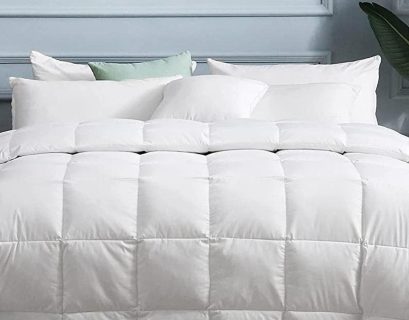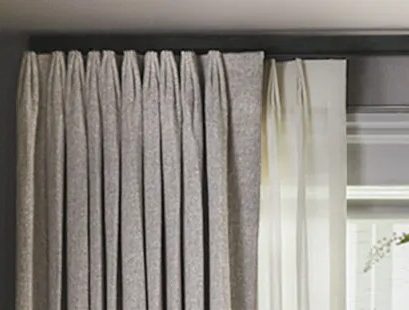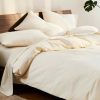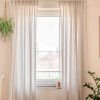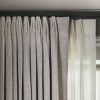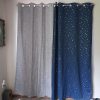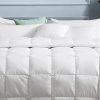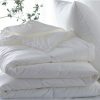In the quest for a restful night’s sleep, the choice of bedding plays a pivotal role, especially for individuals prone to allergies. Hypoallergenic bedding, crafted from materials that resist common allergens, offers a sanctuary for those seeking a respite from sneezing, itching, and other allergy-related discomforts. In this comprehensive guide, we will explore the best materials for hypoallergenic bedding, examining their unique properties and benefits that contribute to a healthier and more comfortable sleep environment.
1. Organic Cotton:
Properties:
- Natural Origin: Organic cotton is cultivated without the use of synthetic pesticides or fertilizers, making it a pure and natural choice for hypoallergenic bedding.
- Breathability: Known for its breathability, organic cotton allows air to circulate freely, preventing the buildup of moisture and reducing the risk of allergen-friendly environments.
- Softness: Organic cotton boasts a soft and smooth texture, providing a comfortable and irritation-free sleep surface.
Benefits:
- Reduced Chemical Exposure: Choosing organic cotton minimizes exposure to harmful chemicals commonly found in conventional cotton, promoting a healthier sleep environment.
- Temperature Regulation: The breathability of organic cotton helps regulate body temperature, ensuring a cool and comfortable sleep experience.
2. Bamboo:
Properties:
- Hypoallergenic: Bamboo naturally repels allergens and is resistant to dust mites and mold, making it an ideal choice for allergy sufferers.
- Moisture-Wicking: Bamboo exhibits excellent moisture-wicking properties, absorbing and dissipating moisture to keep the sleep environment dry.
- Thermoregulation: Bamboo is known for its thermoregulatory qualities, adapting to body temperature and providing a comfortable sleep experience.
Benefits:
- Antimicrobial: Bamboo possesses natural antimicrobial properties, contributing to a cleaner and more hygienic sleep space.
- Sustainable Choice: Bamboo is a rapidly renewable resource, making it an eco-friendly and sustainable option for hypoallergenic bedding.
3. Tencel (Lyocell):
Properties:
- Derived from Wood: Tencel is made from sustainably sourced wood pulp, creating a fabric that is gentle on the skin and hypoallergenic.
- Moisture Management: Tencel excels in moisture management, wicking away moisture and providing a dry and cool sleep surface.
- Silky Smooth Texture: Tencel fabric has a silky and smooth texture, enhancing comfort and minimizing the risk of skin irritation.
Benefits:
- Eco-Friendly: Tencel production involves a closed-loop process, minimizing environmental impact and making it a responsible choice.
- Gentle on Skin: Tencel is often recommended for individuals with sensitive skin, offering a gentle and non-irritating bedding option.
4. Hypoallergenic Microfiber:
Properties:
- Fine Filament Structure: Hypoallergenic microfiber features a fine filament structure that reduces the likelihood of allergen accumulation.
- Resistant to Allergens: Microfiber is naturally resistant to dust mites and other common allergens, creating a more hypoallergenic sleep environment.
- Durability: Microfiber bedding is known for its durability and resistance to wear, maintaining its hypoallergenic properties over time.
Benefits:
- Affordability: Hypoallergenic microfiber bedding is often more budget-friendly than some natural fiber alternatives, making it accessible for a broader range of consumers.
- Low Maintenance: Microfiber is easy to care for and maintain, requiring minimal effort to keep it clean and allergen-free.
5. Silk:
Properties:
- Smooth and Soft Texture: Silk boasts a luxurious and smooth texture, providing a gentle and soothing surface for sensitive skin.
- Hypoallergenic Qualities: Silk is naturally hypoallergenic and resistant to dust mites and other common allergens.
- Temperature Regulation: Silk has excellent temperature-regulating properties, keeping the sleep environment cool in summer and warm in winter.
Benefits:
- Reduced Friction: The smooth surface of silk reduces friction on the skin and hair, minimizing the risk of irritation and promoting a comfortable sleep experience.
- High-Quality Aesthetics: Beyond its hypoallergenic properties, silk adds a touch of luxury and elegance to the bedroom, creating a serene and inviting atmosphere.
6. Natural Latex:
Properties:
- Antimicrobial: Natural latex is inherently antimicrobial, preventing the growth of bacteria, mold, and dust mites.
- Resilience: Latex is known for its resilience and durability, providing long-lasting support without the risk of allergen accumulation.
- Breathability: Latex has natural breathability, promoting proper air circulation and reducing the likelihood of moisture buildup.
Benefits:
- Supportive Comfort: Natural latex offers responsive support, contouring to the body’s curves and providing optimal spinal alignment for a restful sleep.
- Sustainable Option: Natural latex is derived from rubber tree sap, making it a sustainable and eco-friendly choice for hypoallergenic bedding.
7. Hemp:
Properties:
- Antimicrobial: Hemp possesses natural antimicrobial properties, inhibiting the growth of bacteria and allergens.
- Breathable: Hemp is a breathable fabric, allowing for adequate air circulation and reducing the risk of allergen-friendly environments.
- Durable: Hemp is known for its durability, ensuring that hypoallergenic bedding maintains its integrity over time.
Benefits:
- Sustainable Choice: Hemp is a highly sustainable crop, requiring minimal pesticides and water, making it an environmentally conscious choice for hypoallergenic bedding.
- Thermoregulation: Hemp bedding provides excellent thermoregulation, adapting to body temperature and promoting a comfortable sleep climate.
Conclusion:
Choosing hypoallergenic bedding goes beyond addressing immediate allergy concerns—it’s a holistic approach to creating a healthier and more comfortable sleep environment. The materials mentioned above offer a diverse range of options, catering to various preferences, sensitivities, and sustainability considerations.
As you embark on the journey to select hypoallergenic bedding, consider your individual needs, climate, and personal preferences. Whether you opt for the natural softness of organic cotton, the eco-friendly appeal of bamboo, or the luxurious feel of silk, each material brings its unique set of benefits to enhance your sleep experience. By prioritizing hypoallergenic bedding, you not only invest in your well-being but also transform your bedroom into a haven of comfort and tranquility.




